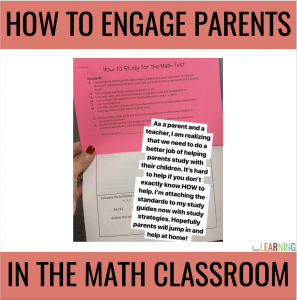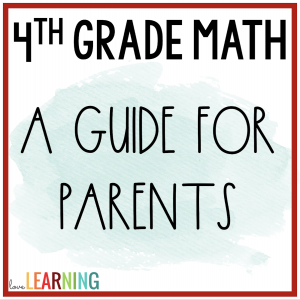
As a 5th grade math teacher and a mom of two girls in third and fifth grade, I’ve learned firsthand how to engage parents in their child’s education, especially when it comes to helping with homework and studying.
I quickly realized that even as a teacher, helping my own children study wasn’t as simple as I thought. Many parents struggle to know exactly what their kids need to study or how to support them, especially in subjects like math.
AS A TEACHER MOM, I HAVE REALIZED A FEW THINGS:
- As a mom, I often had a hard time figuring out exactly what my children needed to study. If they were taking a test on fractions…what exactly did they need to know? Parents need to know how to study with their child.
- We as teachers need to honestly do a better job of giving parents the resources that they need to help their children study or complete homework. I KNOW that we have a million things on our plate already, but trust me, THIS WILL HELP YOU!
- Most parents want to help their children but they honestly don’t know.
Tips for Teachers: How to Engage Parents in Their Child’s Education
1. Share a Math Parent Guide at the Start of the Year
- Parents should know what their child will be learning during the current school year even if they don’t understand all of the strategies that will be used.
- At the beginning of the school year, I send home a 5th Grade Math Parent Guide that lists all of our math learning standards for the year AND gives them sample math problems.
- This is also the best way to help the parents who ask for MORE ways to help their child at home.
2. Simplify Homework to Build Confidence
- I’ve made the honest mistake of sending problems on math homework that were way too challenging. The child struggled, the parent was frustrated, and I received a few too many frustrated emails along the way.
- I strongly believe in spiral review math homework, but I keep it simple. I stick to 6-8 math problems focusing on algorithms only. I leave the high level word problems for math practice in class. It’s as simple as something like this daily decimal practice sheet:
- This way, students are still practicing math at home, but they are problems that the students should be able to complete independently.
- This ALSO gives parents a snapshot of what their child is learning in math.
3. Provide Study Guides Before Tests
- When my child’s teacher sends home a math study guide, I am able to see the problems that she needs to know and use those to practice with her. I can also see what she is struggling with and create “new” problems to help her study further.
- A study guide does not have to be complicated. Simply create a document that lists concepts that students will need to know for the test.
- ✓Quick Tip: if you are using these types of problems on homework already, simply keep the same homework format and change the numbers around.
- I often attach our math standards to the top of the study guide and tell parents when the test will be. I include a parent signature to make sure that parents will see it!
- Here’s an example from my Classifying Polygons Unit:
- By the way, you should NOT be doing this all on your own. You work with a team for a reason. Split the workload! You can do the study guide this month, and your coworker can take your template and do the study guide next month. I have a hard time saying this because I am someone that has a hard time asking for help, but it will save your sanity. We cannot do it all.
4. Share Test Dates and Important Events
- I can’t tell you how many times my daughters have told me “I have a test tomorrow!” the day.before.the.test. 😩 ALL kids do this.
- This tip has been a game changer in my classroom!
- Every month, I send home an editable calendar that lists all of our upcoming events, test dates, and due dates. Actually, I send home a printable copy, an email copy, AND I give each child a copy for the binder. Just to be sure!
- Parents have told me countless times how much the appreciate these! I encourage them to place the parent calendar on their refrigerator at home.

Engaging parents in their child’s education doesn’t have to be overwhelming for teachers. By communicating clearly and providing useful resources, we can build strong partnerships that help students succeed.
Remember, you don’t have to do this alone—collaborate with your team to share the workload and support families better together.
If you’re looking for more teaching ideas, here are 10 Strategies for Teaching Social Studies.
I hope that I was able to inspire you today! Happy Teaching!

PIN THE IMAGE BELOW TO SAVE THIS POST FOR LATER!








